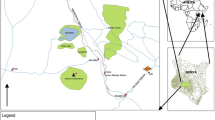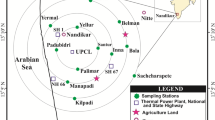Abstract
The distribution and potential sources of 15 polycyclic aromatic hydrocarbons (PAHs) in soils in the vicinity of three South African coal-fired power plants were determined by gas chromatography–mass spectrometry. PAH compound ratios such as phenanthrene/phenanthrene + anthracene (Phen/Phen + Anth) were used to provide reliable estimation of emission sources. The total PAH concentration in the soils around three power plants ranged from 9.73 to 61.24 μg g−1, a range above the Agency for Toxic Substances and Disease Registry levels of 1.0 μg g−1 for significantly contaminated site. Calculated values of Phen/Phen + Anth ratio were 0.48 ± 0.08, 0.44 ± 0.05, and 0.38 + 0.04 for Matla, Lethabo, and Rooiwal, respectively. Flouranthene/fluoranthene + pyrene (Flan/Flan + Pyr) were found to be 0.49 ± 0.03 for Matla, 0.44 ± 0.05 for Lethabo, and 0.53 ± 0.08 for Rooiwal. Such values indicate a pyrolytic source of PAHs. Higher molecular weight PAHs (five to six rings) were predominant, suggesting coal combustion sources. A good correlation existed between most of the PAHs implying that these compounds were emitted from similar sources. The carcinogenic potency B[a]P equivalent concentration (B[a] Peq) at the three power plants ranged from 3.61 to 25.25 indicating a high carcinogenic burden. The highest (B[a] Peq) was found in samples collected around Matla power station. It can therefore be concluded that the soils were contaminated with PAHs originating from coal-fired power stations.


Similar content being viewed by others
References
Agency for Toxic Substances and Disease Registry (ATSDR) (1995c). Toxicological Profile for Polycyclic Aromatic Hydrocarbons, U.S. Department of Health and Human Services, Public Health Service, www.atsdr.cdc.gov/toxprofiles/tp69.html.
Bakker, M. I., Casado, B., Koerselman, J. W., Tolls, J., & Kolloffel, C. (2001). Polycyclic aromatic hydrocarbons in soil and plant samples from the vicinity of an oil refinery. Science of the Total Environment, 263, 91–100.
Braendli, R. C., Bucheli, T. D., Kupper, T., Mayer, J., Stadelmann, F. X., & Tarradellas, J. (2007). Fate of PCBs, PAHs and their source characteristic ratios during composting and digestion of source separated organic waste in full-scale plants. Environmental Pollution, 148, 520–528.
Cai, Q. Y., Mo, C. H., Li, Y. H., Zeng, Q. Y., Katsoyiannis, A., Wu, Q. T., & Ferard, J. F. (2007). Occurrence and assessment of polycyclic aromatic hydrocarbons in soils from vegetable fields of the Pearl River Delta, South China. Chemosphere, 68, 159–168.
CCME (Canadian Council of Ministers of the Environment) (2008). Canadian Soil Quality Guidelines for Carcinogenic and Other Polycyclic Aromatic Hydrocarbons (Environmental and Human Health Effects). Scientific Supporting Document.
Crnkovic, D., Ristic, M., Jovanovic, A., & Antonovic, D. (2007). Levels of PAHs in the soils of Belgrade and its environs. Environmental Monitoring and Assessment, 125, 75–83.
Dahle, S., Savinov, V. M., Matishov, G. G., Evenset, A., & Næs, K. (2003). Polycyclic aromatic hydrocarbons (PAHs) in bottom sediments of the Kara Sea shelf, Gulf of Ob and Yenisei Bay. Science of the Total Environment, 306, 57–71.
Dominguez, C., Sarkar, S. K., Bhattacharya, A., Chatterjee, M., Bhattacharya, B. D., Jover, E., Albaiges, J., Bayona, J. M., Alam, M. A., & Satpathy, K. K. (2010). Quantification and source identification of polycyclic aromatic hydrocarbons in core sediments from sundarban mangrove wetland, India. Archives of Environmental Contamination and Toxicology, 59, 49–61. doi:10-10007/s00244-009-9444-2.
Dor, F., Jongeneelen, F., Zmirou, D., Empereur-Bissonnet, P., Nedellec, V., Haguenoer, J. M., Person, A., Ferguson, C., & Dab, W. (2000). Feasibility of assessing dermal exposure to PAHs of workers on gaswork sites—the SOLEX study. Science of the Total Environment, 263, 47–55.
Guo, J. Y., Wu, F. C., Zhang, L., Liao, H. Q., Zhang, R. Y., Li, W., Zhao, X. L., Chen, S. J., & Mai, B. X. (2011). Screening level of PAHs in sediment core from Lake Hongfeng, Southwest China. Archives of Environmental Contamination and Toxicology, 60, 590–596. doi:10.1007/s00244-010-9568.
Halsall, C. J., Sweetman, A. J., Barrie, L. A., & Jones, K. C. (2001). Modeling the behavior of PAHs during atmospheric transport from the UK to the Arctic. Atmospheric Environment, 35, 255–267.
Kong, S. F., Shi, J. W., Lu, B., Qiu, W. G., Zhang, B. S., Peng, Y., Zhang, B. W., & Bai, Z. P. (2011). Characterization of PAHs within PM10 fraction for ashes from coke production, iron smelt, heating station and power plant stacks in Liaoning Province, China. Atmospheric Environment, 45, 3777–3785. doi:10.1016/j.atmosenv.2011.04.029.
Liu, G. Q., Zhang, G., Li, X. D., Li, J., Peng, X. Z., & Qi, S. H. (2005). Sedimentary record of polycyclic aromatic hydrocarbons in a sediment core from the Pearl River Estuary, South China. Marine Pollution Bulletin, 51, 912–921.
Murakami, M., Nakajima, F., & Furumai, H. (2005). Size- and density distributions and sources of polycyclic aromatic hydrocarbons in urban road dust. Chemosphere, 61, 783–791.
Nadal, M., Schuhmacher, M., & Domingo, J. L. (2004). Levels of PAHs in soil and vegetation samples from Tarragona County, Spain. Environmental Pollution, 132, 1–11.
Nam, J. J., Song, B. H., Eom, K. C., Lee, S. H., & Smith, A. (2003). Distribution of polycyclic aromatic hydrocarbons in agricultural soils in South Korea. Chemosphere, 50, 1281–1289.
Olajire, A. A., Alade, O. A., Adeniyi, A. A., & Olabemiwo, O. M. (2007). Distribution of polycyclic aromatic hydrocarbons in surface soils and water from the vicinity of Agbabu bitumen field of South western Nigeria. Journal of Environmental Science and Health Part A, 42, 1043–1049.
Qiao, M., Wang, C. X., Huang, S. B., Wang, D. H., & Wang, Z. J. (2006). Composition, sources, and potential toxicological significance of PAHs in the surface sediments of the Meiliang Bay, Taihu Lake, China. Environment International, 32, 28–33.
Rajput, N., & Lakhani, A. (2010). Measurement of polycyclic aromatic hydrocarbons in an urban atmosphere of Agra, India. Atmosfera, 23, 165–183.
Ravindra, K., Sokhi, R., & Van Grieken, R. (2008). Atmospheric polycyclic aromatic hydrocarbons: source attribution, emission factors and regulation. Atmospheric Environment, 42, 2895–2921.
Ribes, S., Van Drooge, B., Dachs, J., Gustafsson, O., & Grimalt, J. O. (2003). Influence of soot carbon on the soil–air partitioning of polycyclic aromatic hydrocarbons. Environmental Science and Technology, 37, 2675–2680.
Sanders, M., Sivertsen, S., & Scott, G. (2002). Origin and distribution of polycyclic aromatic hydrocarbons in surficial sediments from the Savannah River. Archives of Environmental Contamination and Toxicology, 43, 438–448.
Sicre, M. A., Mary, J. C., Saliot, A., Aparicio, X., Grimalt, J., & Albaiges, J. (1987). Aliphatic and aromatic hydrocarbons in different sized aerosols over the Mediterranean Sea and origin. Atmospheric Environment, 21, 2247–2259.
Tao, S., Cui, Y. H., Xu, F., Li, B. G., Cao, J., Liu, W., Schmitt, G., Wang, X. J., Shen, W., Qing, B. P., & Sun, R. (2004). Polycyclic aromatic hydrocarbons (PAHs) in agricultural soil and vegetables from Tianjin. Science of the Total Environment, 320, 11–24.
USEPA (1993). Provisional Guidance for Quantitative Risk Assessment of Polycyclic Aromatic Hydrocarbons. EPA/600/R-93/089, July 1993.
Wang, R. W., Liu, G. J., Chou, C. L., Liu, J. J., & Zhang, J. M. (2009). Environmental assessment of PAHs in soils around the Anhui Coal District, China. Archives of Environmental Contamination and Toxicology, 59, 62–70.
Zohair, A., Salim, A. B., Soyibo, A. A., & Beck, A. J. (2006). Residues of polycyclic aromatic hydrocarbons (PAHs), polychlorinated biphenyls (PCBs) and organochlorine pesticides in organically-farmed vegetables. Chemosphere, 63, 541–553.
Acknowledgment
The authors would like to acknowledge the generosity of the executive dean of the College of Science Engineering and Technology (UNISA) for the financial support of Mr O.O. Okedeyi.
Author information
Authors and Affiliations
Corresponding author
Rights and permissions
About this article
Cite this article
Okedeyi, O.O., Nindi, M.M., Dube, S. et al. Distribution and potential sources of polycyclic aromatic hydrocarbons in soils around coal-fired power plants in South Africa. Environ Monit Assess 185, 2073–2082 (2013). https://doi.org/10.1007/s10661-012-2689-7
Received:
Accepted:
Published:
Issue Date:
DOI: https://doi.org/10.1007/s10661-012-2689-7




